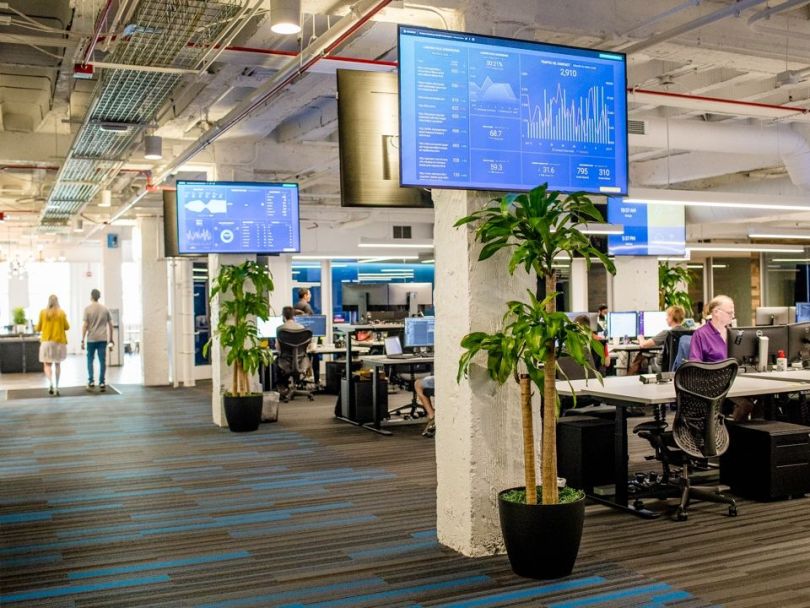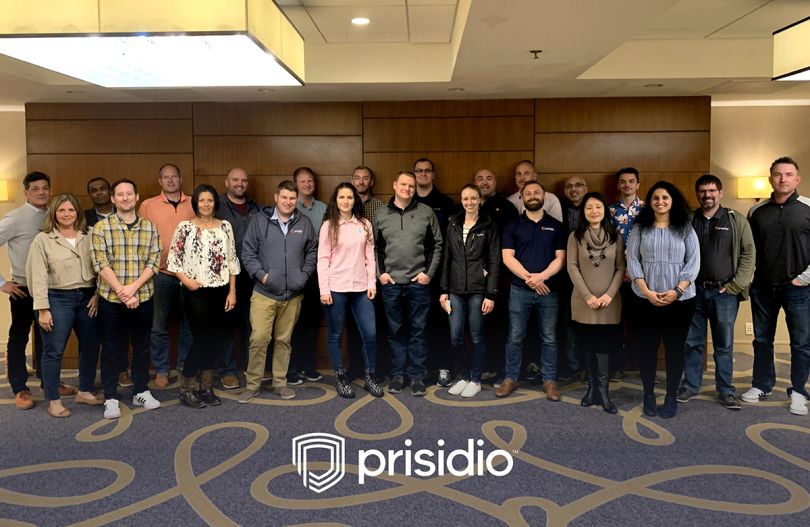Product development is not an inherently exciting process. Not every company solves big problems, encourages employees to see how far they can take side projects or is willing to experiment with new product development processes.
That’s not the case at the following Chicago tech companies, however. Each of the six employers featured below give product teams the opportunity to experiment, solve problems at scale and get creative with their approach.
Take project44, whose newest logistics solution, “Port Intel,” only came onto its roadmap after the product team became curious about a dataset acquired via an acquisition. Then there’s Civis Analytics, which adopted an entirely new product development approach to create its new database query tool.
We caught up with product professionals at project44, Civis and a few other Chicago tech companies to learn about the newest products they’ve launched and what made them so exciting to work on.

On the homepage of project44 is a large banner advertising the company’s newest product, Port Intel. Shane Ham, a senior product manager, gave Built In the inside scoop on the supply chain visibility platform’s newest offering, including the crucial role the company’s Germany-based engineering team played in its development.
Tell us about a recent product your team at project44 launched.
Port Intel is a global real-time market intelligence tool on port congestion and vessel activity that enables supply chain professionals to proactively plan and respond to exceptions. Leveraging our data to build unique market intelligence tools is a part of our product team’s vision, and we are consistently looking for opportunities to create products that deliver market-level insights customers can utilize in their supply chain planning and daily operations.
Port Intel represents the creation of a new product category we refer to as “supply chain intelligence” and is a byproduct of our visibility offering. Port Intel multiplies the value of our core platform and transforms data into actionable information for project44 customers.
Port Intel began as a project to automate various one-off reports.”
What was the biggest challenge your team faced while developing this new product, and how did you overcome it?
Port Intel began as a project to automate various one-off reports. Our acquisition of [the Germany-based] Ocean Insights gave us access to new port and vessel data, and in an environment where innovation is celebrated, our team remained curious about the “what if.” This led to our team taking the initiative to build prototypes.
The creation of the Port Intel platform also gave us the opportunity to integrate people, not just products, around a common cause. When presented with new data via acquisition, we worked with our engineers in Germany to better understand how to navigate the port congestion data, which was instrumental in delivering the Port Intel solution.

Just like a journey of a thousand miles begins with a single step, so too does a search of Tegus’ market intelligence platform — which contains data and insights on over 25,000 public and private companies — begin with a visit to its homepage. The company recently updated its platform’s homepage, and Kelly Bishop, a principal product manager, shared the challenges her team navigated in the process and the trade-offs they had to make.
Tell us about a recent product your team at Tegus launched.
Our goal is to modernize historically manual research methods to better help our customers find signals through the noise. To hit this goal, we are in the midst of realizing an exciting, long-term product vision starting with the homepage due to its lack of dependencies on new technologies or workflows. Outside of minor changes, the homepage had not been revisited since 2017, and our volume of content had outgrown the design. We identified and addressed two key opportunities from the user perspective: “Help me access content I care about faster and make it easy for me to discover new companies.”
Using data to inform our path, we prioritized access to search since it is the most-used functionality. Moving down the page, we organized the content as a pyramid of most relevant to exploratory and built modular sections because we continue to learn how to best support our customers’ discoveries. To start, we surface trending interviews to show companies of high interest and recommend companies to watch based on an individual’s behavior. Our March release resulted in an increase in searches per session and watched companies, a huge driver of sessions!
Outside of minor changes, the homepage had not been revisited since 2017, and our volume of content had outgrown the design.”
What was the biggest challenge your team faced while developing this new product, and how did you overcome it?
A challenge with most development projects is balancing speed and quality. Given that a key part of our vision included updating the design of our product and starting from scratch with our design system, we knew quality was priority. It was a big undertaking for design, required thoughtful engineering structure and most importantly, a ton of communication and coordination.
As one squad started building the new homepage, a second squad focused on the new design system and structure. Our design team worked to prioritize components used on the new homepage to provide a logical roadmap. We tackled speed by having the homepage squad build using existing design elements, although the trade-off was that this put us out of sync with the design system squad.
While cross-team dependencies can be tricky to navigate, our two squads rose to the challenge and we joined forces to become a super squad as the engineers paired on integrating new design components and building out the remaining ones. We all affectionately refer to that time as our “razzle dazzle milestone” and actively look for more ways to collaborate across squads.
UPshow is best known for its marketing technology that’s designed to help businesses turn TVs into promotional screens that engage customers and drive revenue. That said, the company recently expanded into employee engagement, which Lynn Gurschke, product owner, said required working hands-on with businesses to better understand the data they value most.
Tell us about a recent product your team at UPshow launched.
We launched our new back-of-house product offering, UPshow SHIFT, in mid-April. UPshow SHIFT is an employee engagement platform that uses on-premise screens to better reach deskless workers, like cooks, servers, retail sales associates and doctors. UPshow SHIFT helps businesses in many industries tackle the fallout of the Great Resignation and is the only on-screen employee engagement platform that demonstrably improves employee communication, training completion speed and operational excellence while driving revenue for businesses.
The product team worked directly with businesses to pilot UPshow SHIFT.”
What was the biggest challenge your team faced while developing this new product, and how did you overcome it?
We knew from the start that UPshow SHIFT would need to utilize real-time data from different point-of-sale systems (POS), learning management systems (LMS) and other systems to be as impactful as possible. To understand the kinds of data that business owners and employees would find most valuable, the product team worked directly with businesses to pilot UPshow SHIFT. They used this information to build flexible, on-screen templates that work with any POS or LMS to display business-critical information.
Civis Analytics gets that data is important to decision-making and that accessing it can be difficult, which is why it recently launched a new tool to make it easier for users of its data analytics software to query databases. Hanna Zhong, director of product management, said the key to the product’s success was the human-centered design framework used to develop it.
Tell us about a recent product your team at Civis Analytics launched.
We recently launched the “enhanced Query” tool for our flagship product, Civis Platform, a cloud-based data analytics software that empowers stakeholders across the organization to make data-driven decisions. The enhanced Query tool streamlines our customers’ data exploration and analysis workflows. With the enhanced Query tool, our customers can efficiently organize and develop SQL queries, view helpful table and column metadata while developing SQL queries, sort and customize query results, and easily search for past queries, all in one place.
What was the biggest challenge your team faced while developing this new product, and how did you overcome it?
To optimize user outcomes and build a stronger sense of user empathy, we applied a new product development process: a human-centered design framework. The enhanced Query tool team piloted this process and encountered challenges such as shifting their mindset, addressing skills gaps around user research and difficulty laying the groundwork for other product teams to follow.
To overcome these challenges, product, design and engineering collaborated closely and leaned on each other’s expertise. For example, product, design and engineering ideated together by conducting user interviews. Engineering was critical for shaping the user interview questions from a technical lens and looked to product and design to lead the interviews.

Prisidio is on the verge of launching a full release of its product, a mobile app for storing important information and documents like insurance forms, passwords and ID cards. Sarah Mitchell, a product manager, provided a sneak peek at the app and its capabilities, along with the high-level challenges her team has faced working on it.
Tell us about a recent product your team at Prisidio launched.
Prisidio is a cloud-based vault that streamlines your life management tasks. This first-of-its-kind mobile app gives you on-the-go access to the life-essential documents and personal information you need every time you apply, register, renew, subscribe, purchase or confirm proof of identity or ownership.
Using your phone, capture everything you have: digital and physical IDs; medical, financial, and legal documentation; collectibles; property; cryptocurrencies; memberships; contacts; online accounts; safes; key locations; codes; and passwords. Identify where it is and who knows about it. Easily add items (with personal notes or video annotations) and control who can access each one. Any time you or yours need to reference key information, for the everyday processes in life and especially in an emergency, it’s right there for you, securely stored and organized.
Prisidio became available to select early subscribers in April 2022, and its full release is in June 2022.
To create an app people enjoy and trust, we have to stay close to our users.”
What was the biggest challenge your team faced while developing this new product, and how did you overcome it?
Security was our first challenge. If people assemble the keys to every important personal ID, as well as property, medical, financial, and legal documentation into one place, they need to be unquestionably confident their vault is secure. Prisidio’s security-first vigilance is central to every level of operations. The only people able to access your information are the ones you designate.
Our next challenge was convenience: Sure, we all have sensitive documents, items and knowledge stored in file cabinets, safes, hard drives, shared cloud drives, and even the garage. But inventorying it all and making sure just the right people know about it? Cumbersome. That’s where I think Prisidio is a game-changer. It’s a snap to use, and works from your phone, which is always with you.
To create an app people enjoy and trust, we have to stay close to our users. We tested early and often with live users, watched them in action, listened, and acted fast on their feedback. Now, users tell us how much fun it is to walk around the house with their phone and add photos of items to their vault, or get a spontaneous video of grandpa telling the family story of that cherished pocket watch.














